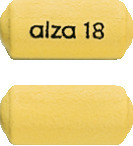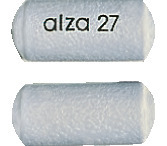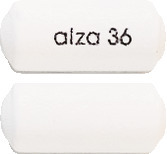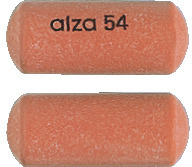SUMMARY CMI
CONCERTA® modified release tablets
Consumer Medicine Information (CMI) summary
The full CMI on the next page has more details. If you are worried about using this medicine, speak to your doctor or pharmacist.
1. Why am I using CONCERTA?
CONCERTA contains the active ingredient methylphenidate hydrochloride. CONCERTA is used to treat Attention Deficit Hyperactivity Disorder (ADHD). For more information, see Section 1. Why am I using CONCERTA? in the full CMI.
2. What should I know before I use CONCERTA?
Do not use if you have ever had an allergic reaction to methylphenidate hydrochloride or any of the ingredients listed at the end of the CMI.
Talk to your doctor if you have any other medical conditions, take any other medicines, or are pregnant or plan to become pregnant or are breastfeeding.
For more information, see Section 2. What should I know before I use CONCERTA? in the full CMI.
3. What if I am taking other medicines?
Some medicines may interfere with CONCERTA and affect how it works.
A list of these medicines is in Section 3. What if I am taking other medicines? in the full CMI.
4. How do I use CONCERTA?
- Children and Adolescents: The starting dose is one CONCERTA 18 mg modified release tablet in the morning.
- Adults: The starting dose is one CONCERTA 18 mg or 36 mg modified release tablet in the morning.
More instructions can be found in Section 4. How do I use CONCERTA? in the full CMI.
5. What should I know while using CONCERTA?
| Things you should do |
|
| Things you should not do |
|
| Driving or using machines |
|
| Drinking alcohol |
|
| Looking after your medicine |
|
For more information, see Section 5. What should I know while using CONCERTA? in the full CMI.
6. Are there any side effects?
Like all medicines, CONCERTA can cause side effects, although not everybody gets them. Your doctor will discuss potential side effects with you and will explain the risks and benefits of your treatment. Some side effects can be serious, and you may require urgent medical attention.
For more information, including what to do if you have any side effects, see Section 6. Are there any side effects? in the full CMI.
FULL CMI
CONCERTA® modified release tablets
Active ingredient(s): Methylphenidate hydrochloride
Consumer Medicine Information (CMI)
This leaflet provides important information about using CONCERTA. You should also speak to your doctor or pharmacist if you would like further information or if you have any concerns or questions about using CONCERTA.
Where to find information in this leaflet:
1. Why am I using CONCERTA?
2. What should I know before I use CONCERTA?
3. What if I am taking other medicines?
4. How do I use CONCERTA?
5. What should I know while using CONCERTA?
6. Are there any side effects?
7. Product details
1. Why am I using CONCERTA?
CONCERTA contains the active ingredient methylphenidate hydrochloride. CONCERTA is a stimulant that increases attention and decreases impulsiveness and hyperactivity in patients with ADHD.
CONCERTA is used to treat Attention Deficit Hyperactivity Disorder (ADHD). CONCERTA is part of a comprehensive treatment program which usually includes psychological, educational and social therapy.
CONCERTA should be used as part of a total treatment program for ADHD that may include counselling or other therapies.
Your doctor may have prescribed CONCERTA for another reason. Ask your doctor if you have any questions about why this medicine has been prescribed for you/your child.
2. What should I know before I use CONCERTA?
Warnings
Do not use CONCERTA if:
- you/your child are/is allergic to methylphenidate hydrochloride, or any of the ingredients listed at the end of this leaflet.
Symptoms of an allergic reaction may include: rash, itching or hives on the skin; shortness of breath, wheezing or difficulty breathing; swelling of the face, lips, tongue or other parts of the body. - Always check the ingredients to make sure you can use this medicine.
- you/your child have/has any of the following medical conditions:
- glaucoma (increased pressure in the eye) which is poorly controlled
- overactive thyroid gland
- heart problems, including severe angina (chest pain), irregular heart beat, heart muscle disease
- high blood pressure (untreated or not under control)
- severe depression, anorexia nervosa, suicidal tendency or other mental illness
- phaeochromocytoma (a tumour of the adrenal gland) - you/your child have/has a history of drug or alcohol abuse
- you/your child are/is currently taking or have taken a monoamine oxidase (MAO) inhibitor, medicines used to treat major depression (e.g. phenelzine, tranylcypromine) or medicines used in Parkinson's disease (e.g. selegiline) within the last 14 days.
- Do not use CONCERTA if the packaging is torn or shows signs of tampering.
- Do not use CONCERTA beyond the expiry date (month and year) printed on the pack.
- If you/your child take CONCERTA after the expiry date it may not work
Check with your doctor if you/your child:
- have any other medical conditions, particularly:
- have/has seizures or fits
- have/has heart problems
Heart-related problems including sudden death in patients who have heart problems or heart defects, stroke and heart attack in adults and increased blood pressure and heart rate have been reported with the use of methylphenidate, the active ingredient in CONCERTA.
- have/had thoughts about suicide or attempted suicide
- have/has high blood pressure
- have/has aggressive behaviour or hostility
- have/has a narrowing or blockage in your digestive tract (stomach, small or large intestine)
- have tics (movements or sounds that you cannot control) or Tourette's syndrome, or a family history of these conditions
- have/has a problem with the blood vessels in your brain (such as an aneurysm)
- have/has eye problems, such as increased pressure in the eye, a condition called "glaucoma" or long-sightedness (difficulty seeing near objects)
- have/has liver or kidney problems
- have/has mental problems including psychosis, mania, bipolar illness, or depression.
Mental (psychiatric) problems may develop or get worse, including behaviour and thought problems, bipolar illness, aggressive behaviour or hostility. - take any medicines for any other condition
- are/is or have/has been alcohol or drug dependent
During treatment, you/your child may be at risk of developing certain side effects. It is important you understand these risks and how to monitor for them. See additional information under Section 6. Are there any side effects?
Pregnancy and breastfeeding
Check with your doctor if you/your child are/is pregnant or intend to become pregnant.
You/your child should not take CONCERTA during pregnancy unless this has been discussed with your doctor.
Talk to your doctor if you/your child are/is breastfeeding or intend to breastfeed.
The active ingredient in CONCERTA passes into breast milk and there is a possibility that your baby may be affected. Your doctor can discuss with you the risks and benefits involved.
Use in elderly patients
CONCERTA is not recommended for use in the elderly over 65 years because it has not been studied in these age groups.
Use in children
CONCERTA is not recommended for use in children less than 6 years because it has not been studied in these age groups.
Abuse and dependence
CONCERTA can be abused or lead to dependence.
Keep CONCERTA in a safe place to prevent misuse and abuse.
3. What if I am taking other medicines?
Tell your doctor or pharmacist if you/your child are/is taking any other medicines, including any medicines, vitamins or supplements that you buy without a prescription from your pharmacy, supermarket or health food shop.
Some medicines may be affected by CONCERTA or may affect how well CONCERTA works. Check with your doctor or pharmacist if you are not sure about what medicines, vitamins or supplements you/your child are taking and if these affect CONCERTA. Your doctor or pharmacist can tell you what to do if you/your child are taking any of these medicines.
In particular, tell your doctor or pharmacist if you/your child are/is taking any of the following:
- monoamine oxidase (MAO) inhibitors such as phenelzine, selegiline
- medicines that increase blood pressure
- medicines used to treat depression or anxiety such as venlafaxine, sertraline, amitriptyline and imipramine
- medicines used to treat high blood pressure. CONCERTA may decrease the effectiveness of these medicines and your doctor may check your blood pressure and change your dose of antihypertensive medicine.
- medicines used for anaesthesia. CONCERTA should not be taken with certain anaesthetics on the day of the operation, as there is a chance of a sudden rise in blood pressure and heart rate during the operation. Tell your doctor if you are going to have an operation.
- medicines used to prevent seizures such as phenytoin, phenobarbitone, primidone and valproate.
- antipsychotic medicines such as olanzapine, risperidone and quetiapine used to improve the symptoms of certain types of mental illness, e.g. schizophrenia and bipolar disorder.
4. How do I use CONCERTA?
How much to take
If you/your child are/is currently taking other formulations of methylphenidate, your doctor will decide the best starting dose.
Children and Adolescents
- The starting dose is one CONCERTA 18 mg modified release tablet in the morning.
- The maximum dose is 54 mg a day taken as one dose.
Adults
- The starting dose is one CONCERTA 18 mg or 36 mg modified release tablet in the morning.
- The maximum dose is 72 mg a day taken as one dose.
Follow the instructions provided and use CONCERTA until your doctor tells you to stop. Do not change or stop your dosage without consulting your doctor first. Your doctor may adjust the amount of CONCERTA you take until it is right for you.
When to take CONCERTA
CONCERTA should be taken in the morning.
How to take CONCERTA
- CONCERTA should be swallowed whole with a glass of liquid. Do not chew, break or crush the tablets.
- CONCERTA may be taken with or without food.
- CONCERTA tablets are made in a modified release form. This means that they release the active ingredient slowly. The outer layer of the CONCERTA tablet dissolves right after it is swallowed in the morning, giving an initial dose of methylphenidate hydrochloride.
- The tablets have a special shell that allows the rest of the methylphenidate hydrochloride to be released from the tablet at a slow rate throughout the day.
- The tablet shell does not dissolve completely after all the drug has been released and sometimes the tablet shell may be seen in your stool. This is normal.
If you forget to use CONCERTA
CONCERTA should be used regularly at the same time each day. If you miss your dose at the usual time, it may be best to wait until the following morning to take the next dose. Remember the effects of CONCERTA are designed to last approximately 12 hours from the time it is taken.
Do not take or give your child a double dose to make up for the dose you missed.
If you/your child have missed more than one dose, or are not sure what to do, check with your doctor or pharmacist.
If you use too much CONCERTA
If you think that you/your child have/has taken too much CONCERTA, you/your child may need urgent medical attention.
You should immediately:
- phone the Poisons Information Centre
(by calling 13 11 26), or - contact your doctor, or
- go to the Emergency Department at your nearest hospital.
You should do this even if there are no signs of discomfort or poisoning.
Symptoms of an overdose with CONCERTA may include vomiting, agitation, muscle twitching, hallucination, dry mouth, excessive sweating, fever, headache, irregular or fast heart beat, dilated pupils, convulsions/fits, breathing problems, confusion and seizures.
5. What should I know while using CONCERTA?
Things you should do
- Always follow your doctor's instructions carefully
- Take CONCERTA exactly as your doctor has prescribed. Like all stimulants, CONCERTA may become habit-forming and can be abused by some people. If you/your child take it correctly as instructed by your doctor, abuse or dependence should not be a problem, either now or later in life.
- Be sure to keep all of your doctor's appointments so that your/your child's progress can be checked.
Your doctor will want to check your/your child's blood pressure and pulse and do blood test from time to time to prevent unwanted side effects. - Tell your doctor if you/your child become pregnant while taking CONCERTA.
- Tell your doctor if you are going to have an operation.
- Parents and/or caregivers should be alert for the development of thoughts or acts of self-harm, hallucinations, abnormal thinking (psychosis) or new or worsening hostility. These were uncommon symptoms seen in clinical studies with CONCERTA and it is not known if they were caused by CONCERTA. Contact your/your child's doctor or mental health professional straight away or seek urgent medical attention if these occur.
- Children should have their height and weight checked regularly as CONCERTA may slow children's rate of growth.
- Tell your doctor if you/your child are/is about to start taking a new medicine, that you/your child are taking CONCERTA.
Call your doctor straight away if you/your child:
- become aggressive, anxious or agitated, or feel more aggressive, anxious or agitated than usual.
- Parents and/or caregivers should contact their/their child's doctor or seek urgent treatment if they/their child develops chest pain, tightness in the chest, shortness of breath, irregular heart beat, feeling faint or loss of consciousness while taking CONCERTA.
- develop severe headaches, weakness or paralysis of any body part, or develop problems with coordination, vision, speaking, finding words or with your memory.
- experience numbness, tingling and a changing colour of the fingers and toes when cold (‘Raynaud's phenomenon’).
- develop prolonged and painful erections, seek immediate medical attention.
Remind any doctor, dentist or pharmacist you visit that you/your child are/is using CONCERTA.
Things you should NOT do
- Do not stop using this medicine suddenly.
If you/your child suddenly stop taking this medicine, you/your child's condition may reappear or you/your child may get unwanted effects such as depression. Your doctor may want to gradually reduce the amount of medicine taken each day before stopping it completely. - Do not change your dose without first checking with your doctor
Driving or using machines
Be careful before you drive or use any machines or tools until you know how CONCERTA affects you.
CONCERTA may impair your ability to operate potentially hazardous machinery or vehicles. You should exercise caution until you are reasonably certain how you react to CONCERTA before you drive a car, operate machinery, or do anything else that could be dangerous.
Drinking alcohol
Tell your doctor if you drink alcohol.
Alcohol may impact the way CONCERTA works.
Looking after your medicine
- Store CONCERTA in a cool dry place where the temperature is below 25°C. Keep the container tightly closed.
- Keep the tablets in the bottle until it is time to take them.
Follow the instructions in the carton on how to take care of your medicine properly.
Store it in a cool dry place away from moisture, heat or sunlight; for example, do not store it:
- in the bathroom or near a sink, or
- in the car or on window sills.
Keep it where young children cannot reach it.
Getting rid of any unwanted medicine
If you no longer need to use this medicine or it is out of date, take it to any pharmacy for safe disposal.
Do not use this medicine after the expiry date.
6. Are there any side effects?
All medicines can have side effects. If you do experience any side effects, most of them are minor and temporary. However, some side effects may need medical attention.
See the information below and, if you need to, ask your doctor or pharmacist if you have any further questions about side effects.
Less serious side effects
| Less serious side effects | What to do |
Stomach or bowel problems:
| Speak to your doctor if you have any of these less serious side effects and they worry you. |
Serious side effects
| Serious side effects | What to do |
Behavioral changes:
| Call your doctor straight away, or go straight to the Emergency Department at your nearest hospital if you notice any of these serious side effects. |
Tell your doctor or pharmacist if you notice anything else that may be making you feel unwell.
Other side effects not listed here may occur in some people.
Reporting side effects
After you have received medical advice for any side effects you experience, you can report side effects to the Therapeutic Goods Administration online at www.tga.gov.au/reporting-problems. By reporting side effects, you can help provide more information on the safety of this medicine.
Always make sure you speak to your doctor or pharmacist before you decide to stop taking any of your medicines.
7. Product details
This medicine is only available with a doctor's prescription.
What CONCERTA contains
| Active ingredient (main ingredient) | methylphenidate hydrochloride |
| Other ingredients (inactive ingredients) | butylated hydroxytoluene carnauba wax cellulose acetate hypromellose lactose monohydrate phosphoric acid poloxamer polyethylene oxide povidone sodium chloride stearic acid succinic acid iron oxide black iron oxide yellow iron oxide red (27 mg & 54 mg tabs only) OPACODE WB monograming ink NS-78-17715 Black (PI 4424) OPADRY complete film coating system YS-1-19025-A Clear (PI 4421) The 18 mg tablet also contains Opadry II yellow YS-30-12788-A The 27 mg tablet also contains Opadry II grey Y-30-17528 The 36 mg tablet also contains Opadry II white Y-30-18037 The 54 mg tablet also contains Opadry II red Y-30-15567-A |
| Potential allergens | Contains lactose. |
Do not take this medicine if you are allergic to any of these ingredients.
What CONCERTA looks like
CONCERTA 18 mg are yellow capsule-shaped tablets, with "alza 18" printed in black ink on one side (AUST R 93862)
CONCERTA 27 mg are grey capsule-shaped tablets, with "alza 27" printed in black ink on one side (AUST R 124502)
CONCERTA 36 mg are white capsule-shaped tablets, with "alza 36" printed in black ink on one side (AUST R 93863)
CONCERTA 54 mg are brownish-red capsule-shaped tablets, with "alza 54" printed in black ink on one side (AUST R 93864)
CONCERTA products are supplied in bottles of 28, 30, 56, 60 or 100 tablets.
Not all pack sizes are marketed.
Who distributes CONCERTA
JANSSEN-CILAG Pty Ltd
1-5 Khartoum Road
Macquarie Park NSW 2113 Australia
Telephone: 1800 226 334
This leaflet was prepared in March 2025.
Published by MIMS May 2025





 Clinical judgement should be used when selecting the dose for patients currently taking methylphenidate in other regimens. If improvement is not observed after appropriate dosage adjustments over a one month period, the drug should be discontinued.
Clinical judgement should be used when selecting the dose for patients currently taking methylphenidate in other regimens. If improvement is not observed after appropriate dosage adjustments over a one month period, the drug should be discontinued. The majority of AEs were mild to moderate in severity.
The majority of AEs were mild to moderate in severity. The majority of AEs were mild to moderate in severity.
The majority of AEs were mild to moderate in severity. The majority of ADRs were mild to moderate in severity.
The majority of ADRs were mild to moderate in severity. The majority of ADRs were mild to moderate in severity.
The majority of ADRs were mild to moderate in severity. Adverse events reported since market introduction in patients taking methylphenidate include suicide, suicide attempt and suicide ideation. No causal relationship between methylphenidate and these events have been established.
Adverse events reported since market introduction in patients taking methylphenidate include suicide, suicide attempt and suicide ideation. No causal relationship between methylphenidate and these events have been established. C14H19NO2.HCl.
C14H19NO2.HCl.